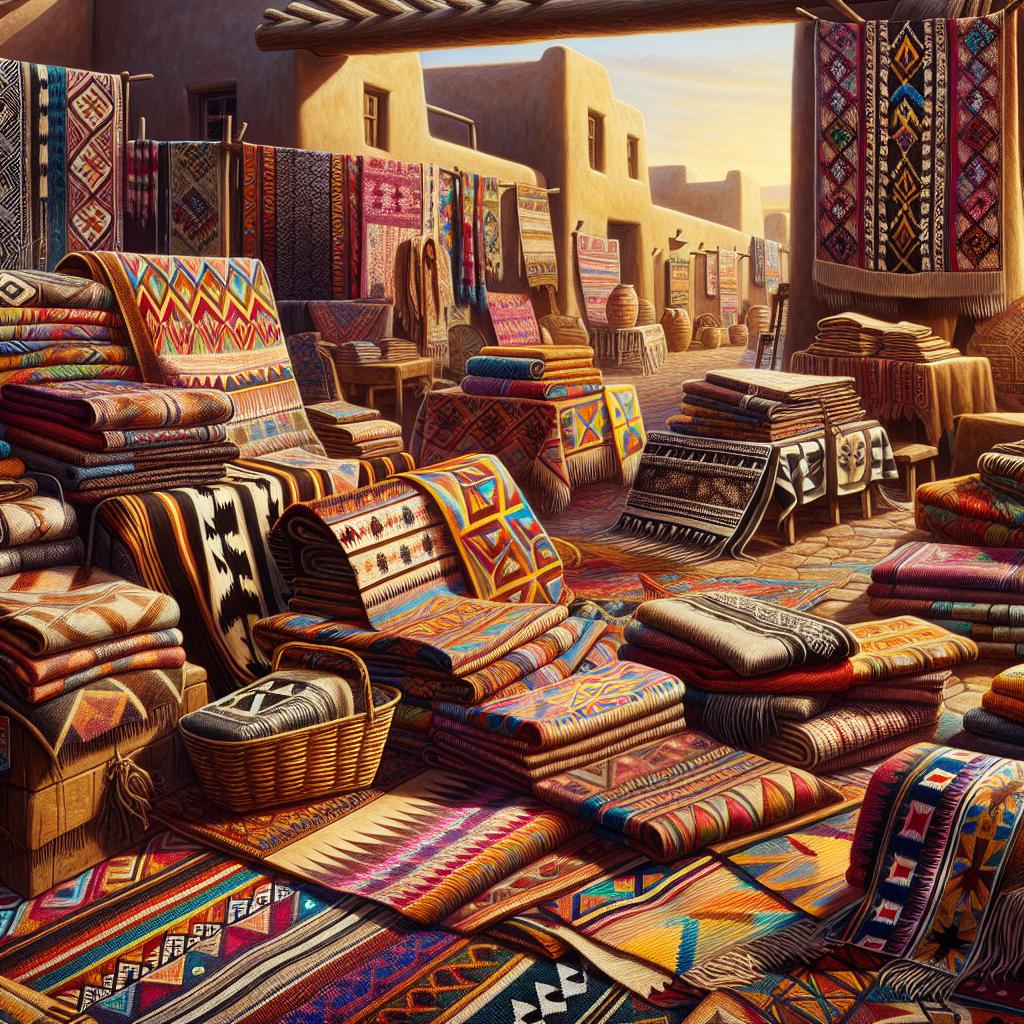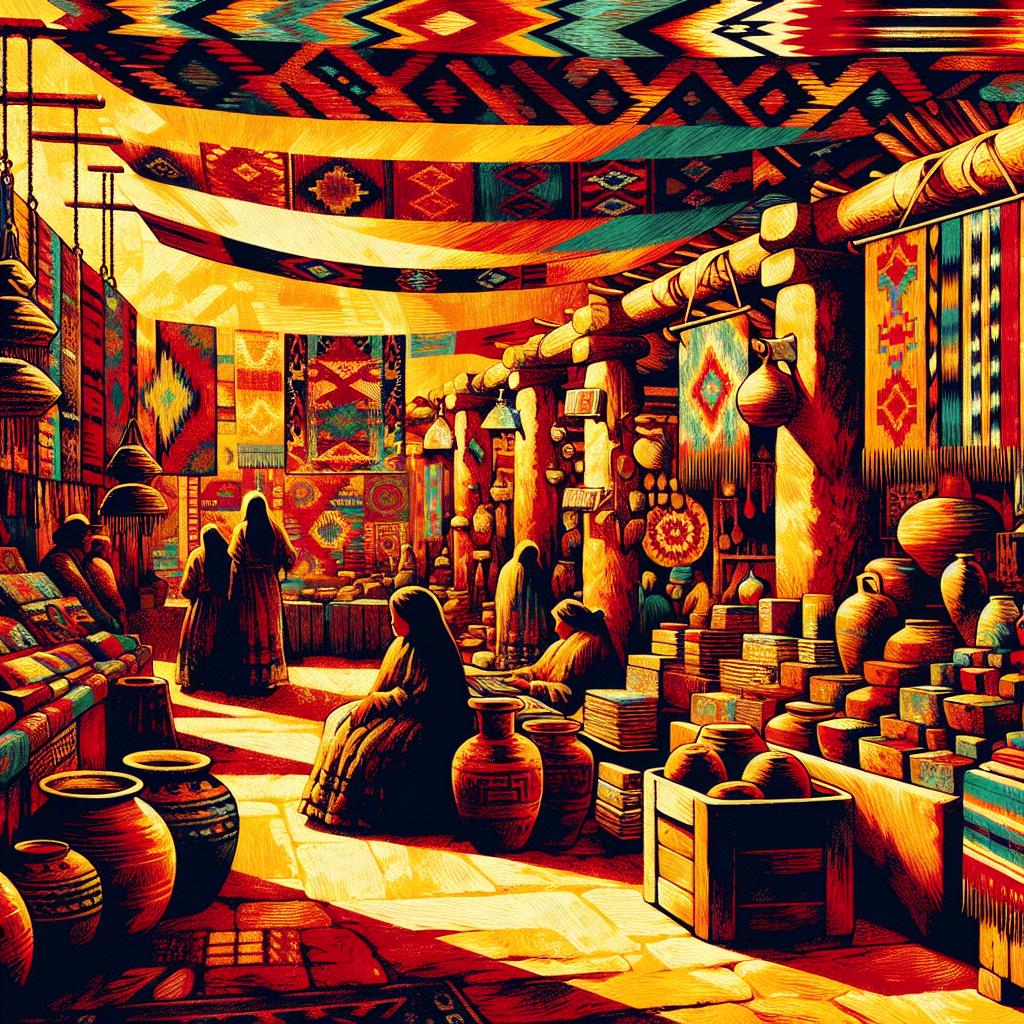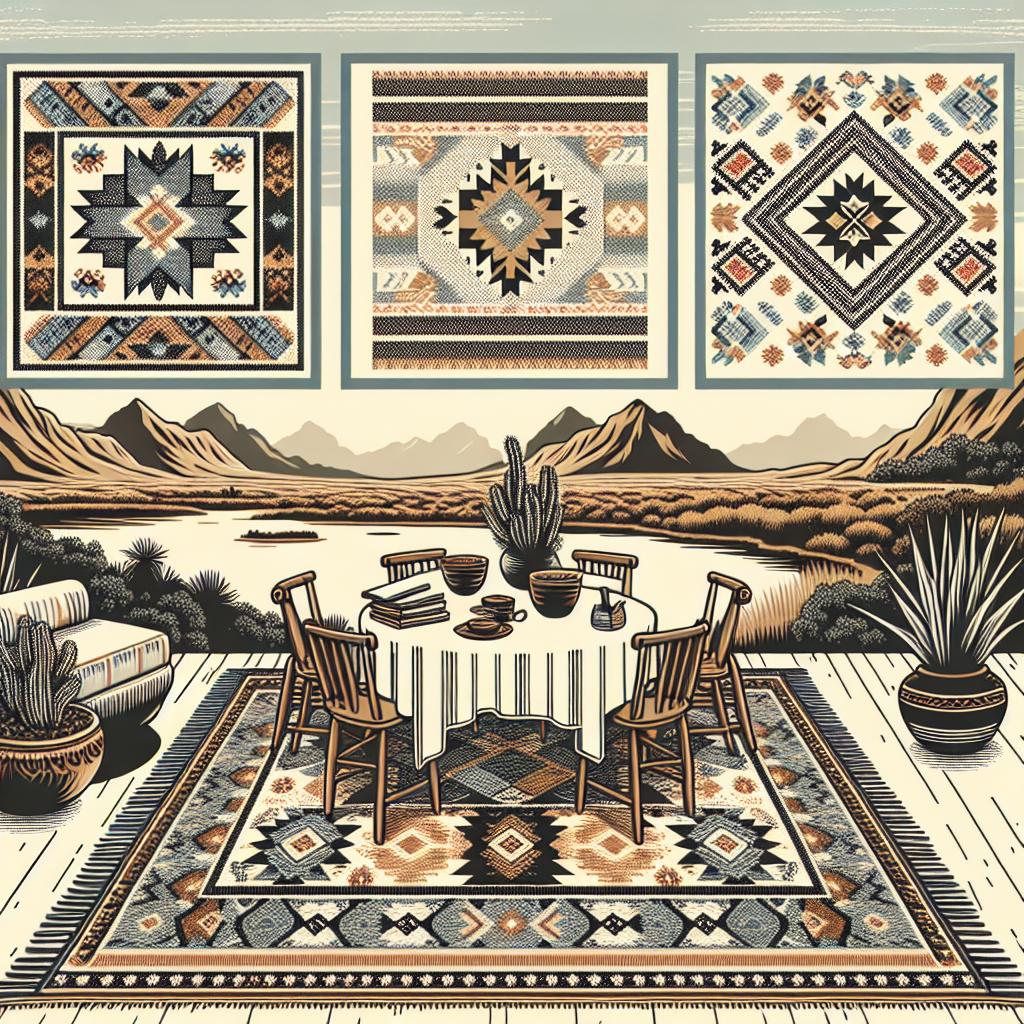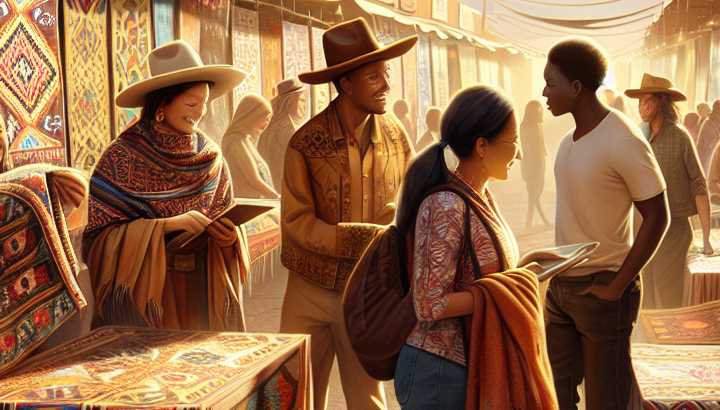Exploring Southwestern Textile Patterns

1. Historical origins of Southwestern textile patterns
Roll up, gather ’round, and pause the binge-watching of your favorite show! We’re going on an amusing journey back in time. Prepare yourself for arid landscapes, spirited ponies, and some really gangsta grandmas weaving up a storm. No, not crips and bloods, but the Navajo and Pueblo tribes – the badass forefathers and foremothers of Southwestern textile patterns.
The real fun in history is all about getting down and dirty – dusting off the secrets buried deep beneath the sands of time. So buckle up, Dorothy, because you aren’t in Kansas anymore; you’re in good ol’ Southwestern United States, peeking into the lives of hilariously serious folks from a millennia back.
“Didn’t know history could be so full of snark!” you may exclaim. Well, welcome aboard, buckaroos.
The origins of Southwestern textile patterns are as colorful as the patterns themselves, as beautifully complex as the intertwining weaves that these tribes painstakingly created. To start off, we must tip our hats to the most influential tribes — the Navajo and Pueblo — who were the Original Gangsta’s of these woven wonders.
Imagine a time around 1000 AD. No electricity, no GTA, no emojis – a dark time, indeed. But out of this potential boredom, something intricate and incredible was born. Picture Chief Big Boss belting out a tune (back then, singing was like TikTok minus the cringe) while Granny Rocks-a-Lot weaves a cosmic pattern on her loom.
Hold up – a cosmic pattern? Yes, my rapidly-blinking comrades, here comes the awesome part. Many textile patterns drew inspiration from Mother Nature, like an early Bob Ross, painting with wool instead of brushes. From the spiraling galaxies to the annually recurring patterns of the seasons, all were represented in these woven wonders. An offbeat interpretation of what a diary could be, their textile was a silent, vibrant testament to their lives.
The Pueblo and Navajo tribes loved symbolism like a toddler loves a smartphone. Every pattern carried a meaning, every color, a purpose.
“The three set about carrying out their plans before they notified their employers of their intention to leave—Miller going so far as to order certain iron castings needed in the construction of their works, made after patterns owned by the Everests”
~
Ida M. Tarbell, The History of the Standard Oil Company
For example, the Navajo tribe often featured patterns like the zigzag lightning, representing male rain, or the terraced cloud, symbolizing female rain. Imagine having a weather forecast woven into a rug – take that, Apple Weather!
The Pueblo tribe, on the other hand, was all about that geometric pattern life. Triangles, squares, lines – if it’s got angles, they’ve got it covered. They integrated these patterns so seamlessly into their textiles that it became a form of tribal identity. “I’m Ted, I’m from the Triangle Tribe…You must be Bob from the Square Squad, right?” Imagine that conversation at a tribal party.
Even after the Spanish invasion in the 16th Century, these Southwestern braves stuck to their guns. Or rather, looms. The southwestern textile tradition continued, albeit with a touch of Hispanic flair. Enter the Saltillo serape – a multi-colored textile featuring that infamous diamond shape at the center. Boom! Now, that’s a fashion statement to knock your socks off.
So, as we weave (pun absolutely intended) our way to the end of this vibrant yarn (couldn’t resist another), remember to appreciate the next southwestern textile pattern you see on a rug, a scarf, or a throw pillow. Humble as they may seem now, these textiles are a wearable diary, a woolen weather forecast, a flamboyant flair of the past. And that, my friends, is no ordinary stitch or weave. That’s a thread of history, as woven by the OGs of the weaving world: Granny Rocks-a-lot and her tribe. And that’s a pattern worth remembering!
Learn More: 1. Historical Origins Of Southwestern Textile Patterns

2. Symbolism and cultural significance in Southwestern patterns
Title: Talking Totems: Unraveling the Enigma of Southwestern Patterns
Ever glanced at a Southwestern rug and got stuck in an artful trance, mesmerized by the merriment of colors and the intricate patterns? Well, friend, you’ve unwittingly been drawn into the rich tapestry of Southwestern art, a vibrant world where every dashed line, curvy swirl, and geometric figure brims with age-old wisdom. It’s like a game of Pictionary, but instead of drawing your cat using a salt shaker, you’re unraveling centuries of Native American culture and history.
Sit back, pop open a can of soda, and let’s embark on an exciting odyssey of understanding the symbolism and cultural significance in Southwestern patterns, where each zig-zag and spiral is more than just a squiggle to add a vivid splash to your living room decor!
1. The Churro Lamb’s Odyssey
Let’s set the scene with the Churro sheep, the veritable Picasso of the Navajo tribe. This humble creature and its wool have metamorphosed Southwest’s weaving tradition into the vibrant tapestry that it is today. Long before the “Take your Sheep to Work” day became a fad, these fleecy fellas were considered sacred and indispensable. How is this relevant to our pattern palooza? Well, the Churro’s wool sets the canvas for the weavers to weave their magic.
2. Geometric Genius
Southwestern patterns often bear an uncanny resemblance to a Geometry 101 lecture. Triangles, squares, diamonds, crosses – the full gambit! But don’t worry; there’s no imminent pop quiz; these are simply instances of symbolism hidden in plain sight.
Triangles frequently symbolize mountains or the elements – think Earth, Wind, and Fire, minus the infectious disco vibe. Squares denote the idea of balance and certainty, akin to the feeling when you balance your checkbook or find that lost TV remote. Diamonds, depending on their orientation, could hint towards the trusty, foursquare stars or deceitful, sly snakes. Bet you didn’t imagine that your placid throw rug had such an intense secret life, right?
3. Whirling in the Whorls
Often seen in Southwestern patterns, spirals imbue a sense of natural harmony and the circle of life; akin to the perpetual spinning of your laundry in the washer. In Pueblo culture, spirals can symbolize journeys, either life’s spiritual journey or literal traveling.
“They made new patterns; the Diamond Company leased a plant and got some machinery in by express”
~ Henry Ford, My Life and Work
Next time you see a spiral, consider it your calling to embark on a journey, even if it’s just to the fridge for a midnight snack.
4. Radiant Radials
No, these aren’t the lovechild of tie-dye artistry and centrifugal force. Radiating patterns in Southwestern art are sun symbols, traditionally associated with constancy, brilliance, and life-giving energy. Think of these patterns as nature’s solar panels, providing a jolt of cultural vibrancy and history, no wiring needed!
5. The Mighty Zigzag
Zigzags are a mainstay in Southwestern patterns generating excitement and movement. Depending on their usage and the weaver’s interpretation, they can indicate everything from water flow to lightning. Use caution – owning a rug with many zigzags suddenly becomes as electrifying as having Thor’s hammer Mjölnir sprawled across your floor!
Southwestern patterns are not just about pretty colors and intricate handiwork; they’re a beautiful intertwining of symbolism and cultural history. Each piece is a chronicle of human experience, wisdom, and exuberant creativity, akin to Grandma’s storytelling but with a more colorful twist and less side-eye.
So, the next time you marvel at a Southwestern pattern, you’ll be conversant with its rich, cultural heft. And when your friend visits and nonchalantly comments on your rug, imagine their surprise when you riff off about the mountains, the spiritual journey, and the constancy of the sun. Your rug will suddenly acquire a new respect, and you’ll be the cool cultural guru!
Whether it’s for your next party trick or to appreciate the culture, mastering this special language of symbols will let you weave tales as vibrant and intricate as the patterns themselves.
Remember, in the world of Southwestern patterns, it’s never just a pretty zigzag—it’s a tale waiting to be told.
Learn More Here: 2. Symbolism And Cultural Significance In Southwestern Patterns

3. Modern uses and interpretations of Southwestern textile designs
Title: The Woven Wonders of the Southwest: Modern Embodiments and Imaginations
Imagine you’re standing in the heart of the mystical Southwest – lands that have felt the whispers of countless winds, a place where crimson horizons birth the sun each day. Picture feeling a sense of awe and fascination as you’re surrounded by bursts of colors and intricate patterns that seamlessly blend into the textile designs the native artists craft. Now, surprise! You’re not in the Southwest at all; you’re in a hip urban loft in downtown Manhattan, dazzled by the transformative magic of Southwestern textile designs, cleverly integrated in modern settings.
Southwestern textile designs have long been admired for their symbolic nature, vibrant colors, and their ability to weave stories that span generations. Today, they are not just surviving but thriving, having intelligently snuck into the twenty-first-century style in an impressive fashion. Let’s trace the winding threads that lead us from traditional uses to contemporary chic, focusing on three modern interpretations of these mesmerizing designs.
1. Motivated by the Modern: Home Décor and Furnishings
The saying “out with the old, in with the new” goes into the proverbial recycling bin when discussing Southwestern textile designs. Modern interior decorators have surreptitiously reintroduced traditional patterns into avant-garde bedrooms and stylish lounges, making you rethink what’s old and what’s new. Southwestern textiles are enjoying their glory days as throw blankets, sleek accent pillows, and on eye-popping rugs that are underfoot but never underappreciated. These designs add an eclectic narrative amid clean-lined modern furniture, encouraging a dialogue between the old and new worlds. An added plus for those of us arguably too fond of an “oops, spilled my merlot” moment, the bold colors are forgiving of the odd mishap.
2. Fashion Forward: Southwestern Prints on the Runway
Fashion is no stranger to borrowing from the times of yore, and Southwestern textile designs have strutted their stuff right onto the runway in recent years.
“I have penetrated your disguise, and understand your villainous designs–I am no longer deceived”
~ Frederick Forest, Iron Hand, Chief of the Tory League
The vibrant hues and geometric patterns have been sewn into haute couture dresses, twirled into lavish scarves, and even stamped onto leather boots — a cheeky nod to the cowboy origins of the Southwest. They’ve transformed from blankets once worn for warmth to statement pieces that make the models sizzle on the catwalk, whispering tales of distant Arizona deserts and surreal New Mexico landscapes with every swish of their skirt.
3. Technologically Traditional: Digital Art and Graphics
This may surprise you, but Silicon Valley and dusty blankets hand-woven by Pueblo weavers have found common ground. Artists and designers across the globe are using digital software to remix these traditional designs into psychedelic graphics on modern mediums. Transformed into digital art, the once-earthy textile motifs now thrive on smartphone wallpapers, web designs, and high-definition music album covers. It’s tradition meets tech in an extraordinary fusion, proving once again that Southwestern textile designs have a timeless beauty that bends all bounds.
From homes that echo with whispers of the past to fashion runways that bring it into the present, right to the digital future, Southwestern textile designs are woven into the very fabric of modern aesthetics. And even though these adaptations have a new look and function, they still retain the core essence and charm of their Southwestern origin. Just goes to show, you can take the textile out of the Southwest, but you can’t take the Southwest out of the textile. The weavers would be so proud!
Source: 3. Modern Uses And Interpretations Of Southwestern Textile Designs
